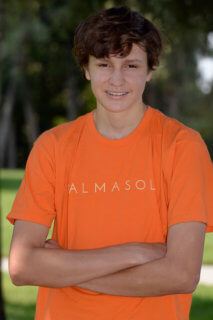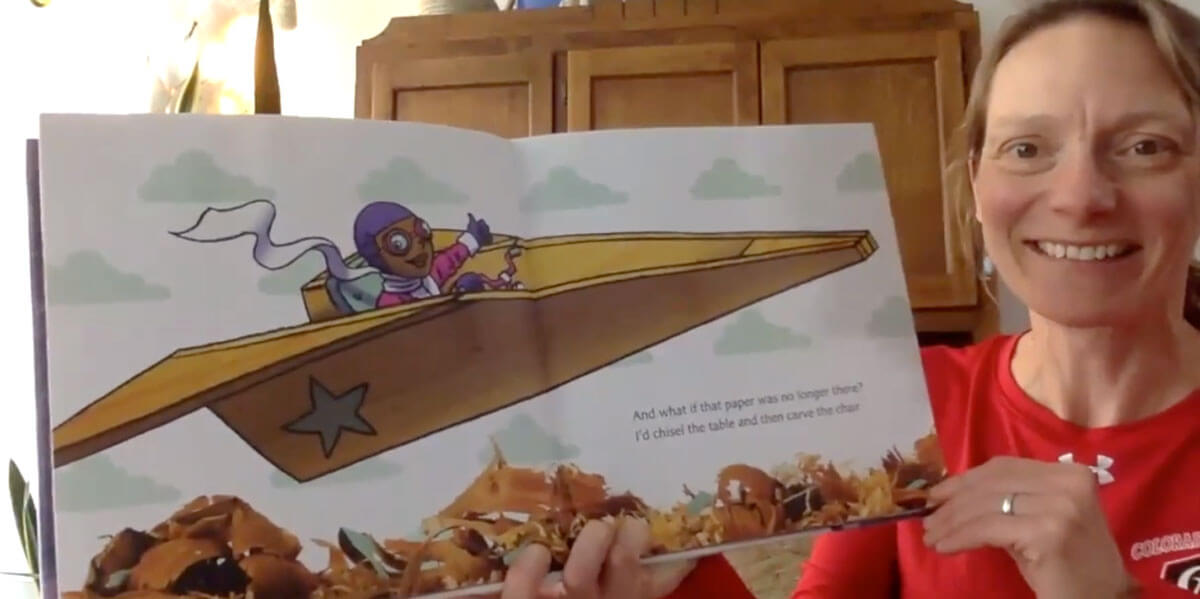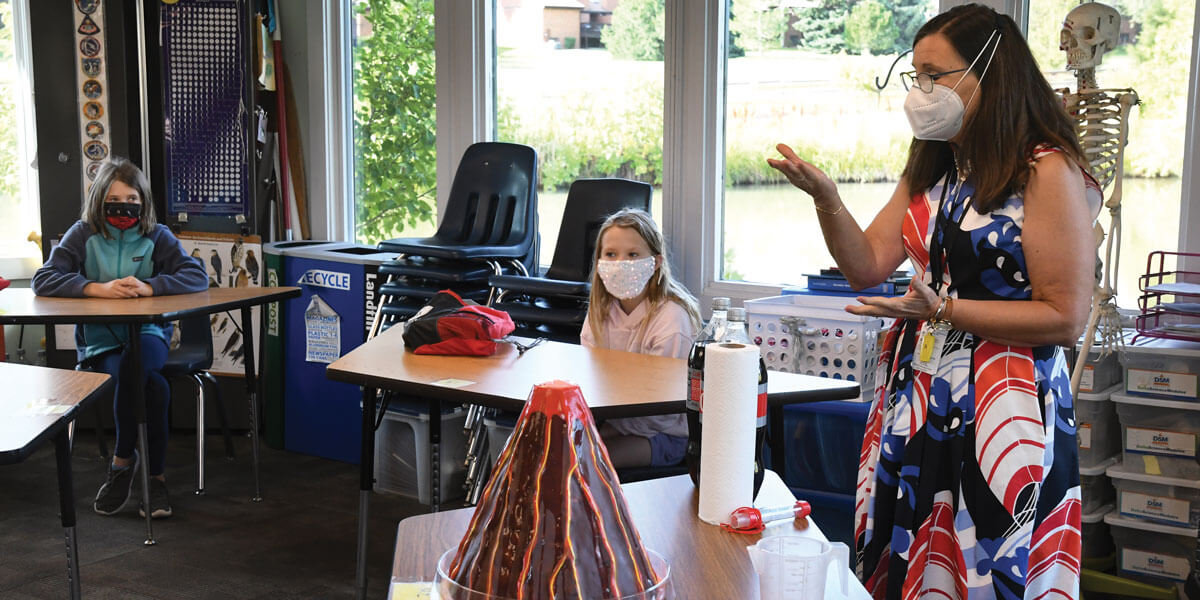 Editor’s Note: This is final in a series of articles about ways that Colorado Academy is living its mission during challenging times.
Editor’s Note: This is final in a series of articles about ways that Colorado Academy is living its mission during challenging times.
Woody’s Pond
Look for Lower School Science Teacher Diane Simmons, and most likely, you will find her in the classroom built over Woody’s Pond. COVID-19 has not changed that. In her own words, Simmons talks about how she is keeping her students curious during a pandemic.
“Students are just naturally curious. As they walk to Woody’s Pond, they are looking around and they want to know ‘Why is there fog over the water? What are those bubbles in the water? What kind of bird is that? What are cattails? Why did the duck dive under the water?
“Before they even enter the classroom, I am answering questions they are curious about, and that sets the stage for the classroom curriculum. Curiosity is part of our mission as science teachers, and COVID has not changed that. We want students to be curious, and we do things to encourage it. We regularly do experiments, and we analyze the results: ‘Why did that happen? Why did it work? Why did it not work?’ We are always trying to get to the ‘Why?’
“During COVID, we have to find the best way to do experiments, because they can’t touch things like they did before. I use materials that I can either wipe down or replace. In some cases, I demonstrate the experiment, and they observe me, but they still must do the analysis. My curriculum has not changed during the pandemic. Whether they are learning in person or remotely, students are getting the same material, so they will not have gaps in their learning.
“I learn every single time I teach something. I am always changing, updating, and researching, demonstrating my own curiosity. The students can see that, like them, I am also a lifelong learner.”
REDI Lab

When Senior Sam Ehrman began his self-directed trimester-long learning project in REDI Lab during his Junior year, he thought he might want to spend the trimester doing actual lab research, but that plan would not have been possible during a pandemic. Instead, Ehrman met with REDI Lab Coordinator Tom Thorpe, who asked him questions designed to redirect his curiosity.
“In REDI Lab, they want your project to be not just an ‘idea” but it has to be something that is very important to you,” Ehrman says. “They want you to figure out your ‘Why,’ and everyone’s ‘Why’ is different. For me, I wanted to find what would drive people to make progress and change.”
Ehrman did some self-reflection and came to the conclusion that he was more easily motivated by activities that demanded short bursts of high energy with an immediate result. When it came to activities that demanded long engagement, he had a tendency to procrastinate. Could he break that habit, he wondered? His research led him to the famous study done by Pavlov, pairing a stimulus with a conditioned response in dogs.
Ehrman’s curiosity led him to develop a stimulus for himself (flicking a rubber band on his fingers), which was designed to condition him to start working on a project he had postponed. Then he widened his research to fellow students who had various bad habits they wanted to break or good habits they wanted to create. His final conclusion was that even when people have good intentions to have good habits, they need an external force outside their control to kickstart them into action.
“REDI Lab gives you the time to dig deeply into a subject,” Ehrman says. “More than you ever have before, you can let your curiosity run wild.”
Now in his Senior year, Ehrman is beginning his college search. He says REDI lab taught him what he wanted to do with his life. His top choices for schools are all large research universities.

The Libraries
How can you keep curiosity and community alive when the libraries are closed? That was the challenge faced by CA librarians when the pandemic struck. Their answer evolved into the very popular “Books and Bedtime” series, as each librarian—Allison Peters Jensen, Allie Bronston, Mary Leyva, and Becci Marzonie—took turns reading a bedtime story over Facebook to CA students.
“It was a strange time, so we wanted to surprise the kids with funny stories,” Peters Jensen says. “We hoped those books would make them curious about other books in the library.”
The librarians also chose stories that brought comfort, keeping in mind that after weeks of remote learning, students may have read every book in their homes. Before long, Peters Jensen started hearing from parents.
“I had curious parents emailing me saying, ‘I get that the library is closed, but can you help with some recommendations for new books?’”
As the summer evolved into a time of national racial unrest, the librarians had another request from parents: “Can you recommend books that will help us educate ourselves and talk with our children about systemic racism?” In response, CA’s team of librarians collaborated with Director of Inclusivity Sarah Wright and drew up a list of books that examined racial issues for all ages and audiences—parents, children, faculty, and staff.
“We were bold in our choices,” says Peters Jensen. “[Head of School] Dr. Davis made a strong statement about the need to educate ourselves about American history and the way people of color had been treated, and we felt the library could aid in the learning process.”
The learning has continued into the fall. In Middle School, Librarian Allie Bronston is conducting the “Bingo Challenge,” which encourages students to read outside their normal genre. “It’s made their curiosity grow,” says Peters Jensen. “When they read a book about someone who is different, they ask whether there are more books about people who face these kinds of challenges.”
With Peters Jensen, all Third Graders are reading the book, It’s Okay to be Different. “We put all 56 of the library’s stuffed animals together, and we talked with students about what makes them different,” Peters Jensen says. “I was so curious to hear what they had to say. Because we have so much rich content in the library, we often talk about how a community is stronger because of its differences. Our students are so ready to have these conversations.”
